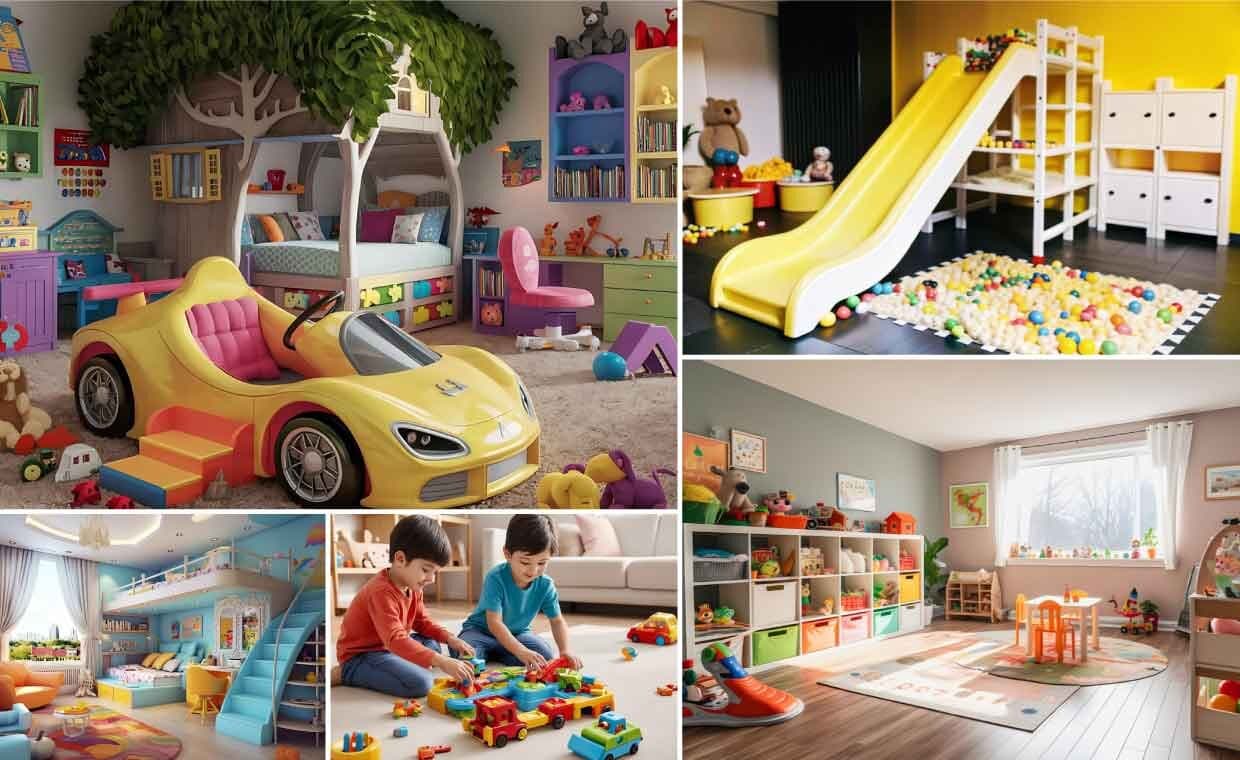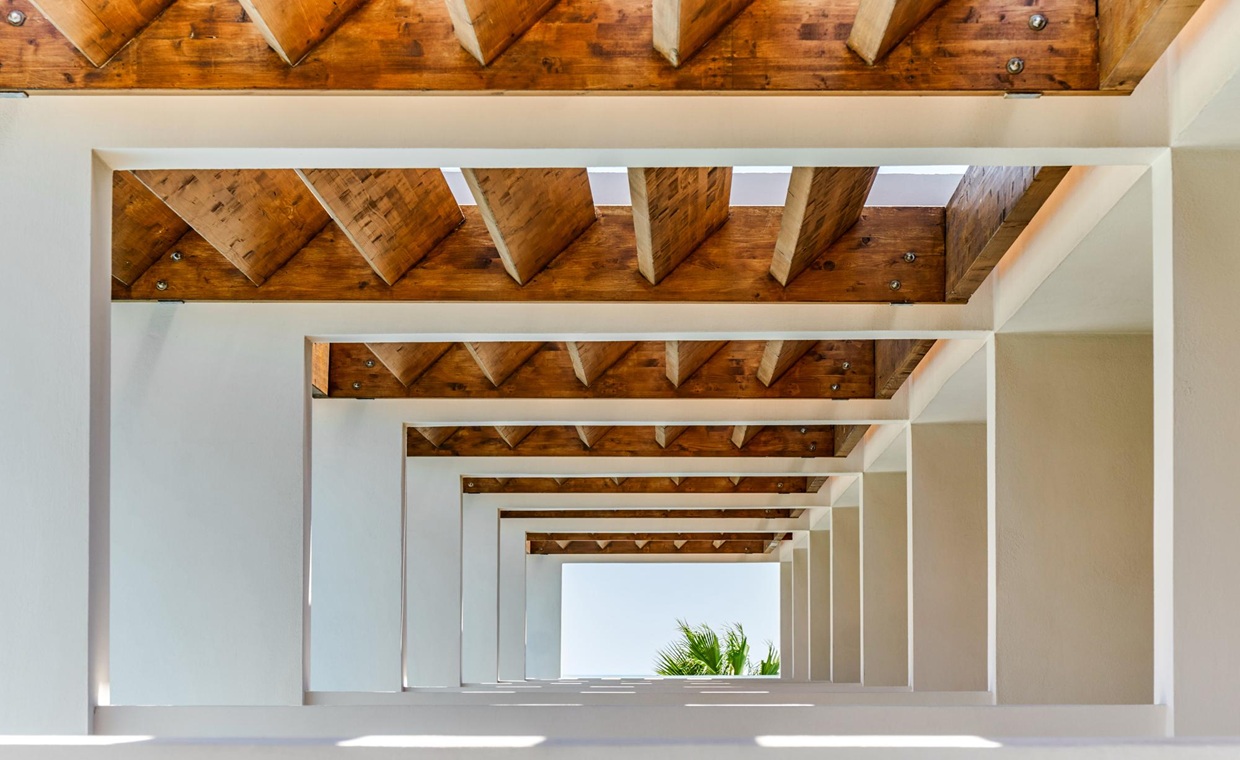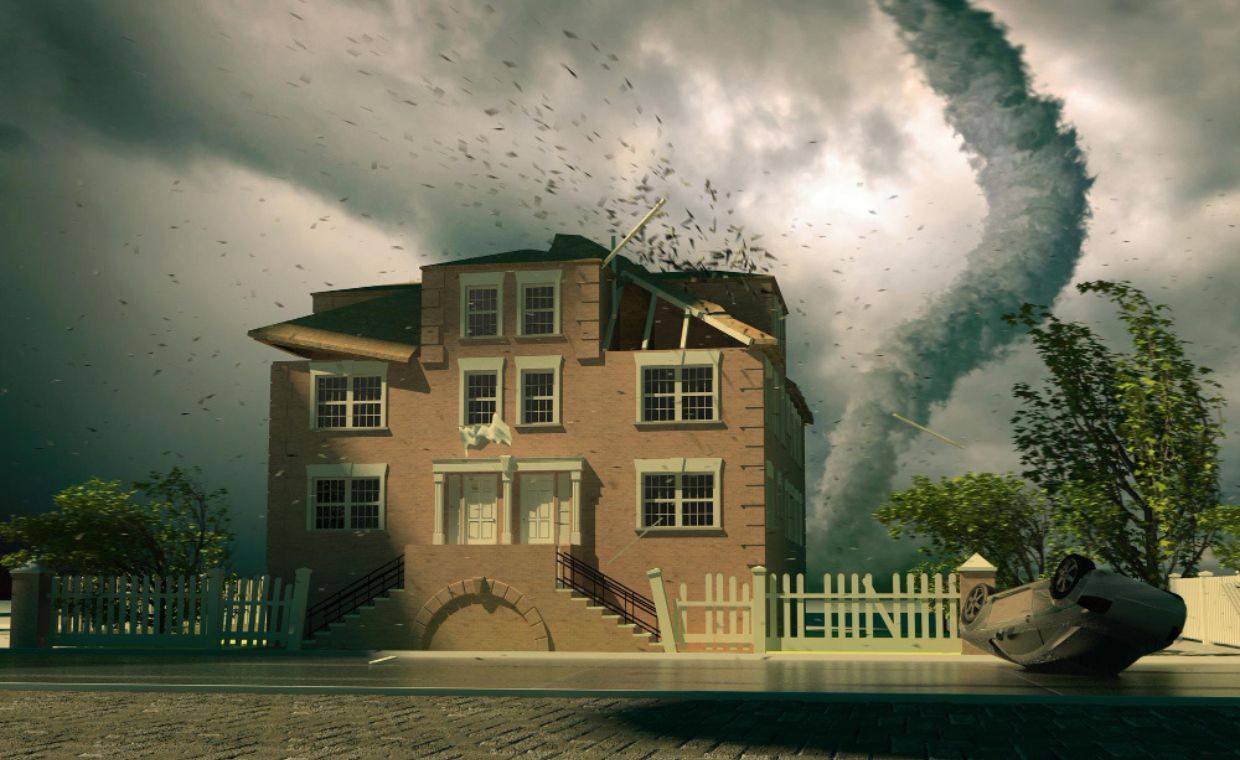
Table of Contents
Children are naturally bound to run around, play, and unleash havoc inside their homes. This is truer today because urban environments deprive children of open outdoor play areas. In such a situation, having a well-planned personal kids’ playroom in your home for your child is the best way out.
You may provide an area for your kids to explore and let their imaginations run wild. However, when curating these settings, you must exercise caution—the entire notion of playroom design centers around a comfortable and enjoyable space for children.
Now let’s dive into 18 tips for creating a vibrant and engaging kids’ playroom.
Top 18 Playroom Design Ideas for Kids
Below is a list of 18 playroom design ideas for you:
- Vibrant Colour Schemes to Stimulate Imagination
- Space-Saving Furniture with Multiple Uses
- Incorporating Playful Elements into Decor
- Learning Through Play: Educational Design Features
- Whimsical Storage Solutions
- Creative Corner for Budding Artists
- Imaginative Dress-Up Station
- Trophy Wall for Little Champions
- Smart Toy Organization Systems
- Reading Nook with Kid-Friendly Bookshelves
- Defined Activity Areas within the Playroom
- Themed Playroom Concepts
- Engaging and Interactive Wall Designs
- Adaptable Furniture for Growing Kids
- Multi-Sensory Play Spaces
- Screen-Free Entertainment Zone
- Customizable Areas for Personal Expression
- Bringing the Outdoors In: Nature-Inspired Elements
1. Vibrant Colour Schemes to Stimulate Imagination

Humans, especially children, love visual features. Colours, shapes, and patterns captivate them. So, while decking up your child-friendly playroom designs, the colour scheme is the first thing that you must be clear about. Start by asking your kids about their favourite colours and fill the area with bright colours. Choose an energetic and warm colour scheme that includes yellows and reds. Their preferences may be difficult to recreate on walls. But try to align with their choices while striking a balance with the colour scheme in the rest of the house.
Also read: How to Choose the Best Color for Bedroom Walls
2. Space-Saving Furniture with Multiple Uses

When children are having fun, they are less inclined to listen to adults. So, it is rather unrealistic to expect kids to understand the function of each piece of furniture and use it appropriately. Why not make these pieces of playroom furniture versatile to accommodate the needs of your children? One smart way to do this is to provide storage for all these furnishings and make the nursery furniture compact.
Parents often customise multi-functional furniture according to the child’s age and requirements. But many pieces of furniture, like cradles, become obsolete after the toddler outgrows them. Why not make it a detachable piece of furniture that can transform into a rocking chair and eventually a seating stool as the child grows? Think outside the box, and then you will realise that you don’t need a separate whiteboard and a table. Your table can have a scribbling surface.
3. Incorporating Playful Elements into Decor

Children have a very short attention span! As a result, you must design the play space with elements that will keep them engaged. You can offer them a room filled with various games and riddles. A playhouse, a swing, their favourite toys like Jellycats in easily accessible cupboards, etc. In other words, the more you squeeze in, the longer you’ll be able to go between demands for attention or help.
Another thing to remember is that kids are energetic and want to explore. You can also incorporate adventurous elements. Install a climbing wall, ladders, or rope dangling from the ceiling. If you have a large space, you can also experiment with indoor play structures, like trampolines and indoor slides.
4. Learning Through Play: Educational Design Features

Fill the playroom with educational toys and games that stimulate the mind and encourage learning through play. Store puzzles, building blocks, and interactive games in bins or shelves, making it simple for kids to dive into fun and learning anytime.
Let’s create a Playroom that Reminds us of our Childhood!
When we were kids, we all wanted a playhouse! Let us design a play place for our children that reflects their desires and objectives. As this is more of a personal area for the children, you must include them in the design process. Let it be a space where they may express their creativity and enjoy their childhood!
5. Whimsical Storage Solutions

Keeping the playroom organised is essential for stimulating play and maintaining structure.
Having a place for everything promotes logical reasoning and natural progression in creativity. But it doesn’t have to be dull. You may add kid-friendly cabinets and drawers, making it easier for them to organise their stuff. Go by colours and these while allocating the cabinets.
If you want your children to be self-reliant from an early age, delegate chores to them. Allow them to sort their possessions first. To do this, ensure the cabinets are ergonomically appropriate for your child.
6. Creative Corner for Budding Artists

If your children are creative, then look for playroom design ideas with a dedicated workspace in the play area. This will be a great addition where they may work on their assignments or craft DIYs. Arts, schoolwork, and tutoring may all benefit from a dedicated table. This way, you can foster their passion for creating and learning. Creativity and order are essential when designing a child’s workstation. Additionally, make sure the design of the desk matches the personality and interests of the child.
Curate the workspace with personal touches like a customised pegboard or chalkboard. Jazz up a plain desk with some terrific wall organisers. Display your children’s works of art. You can have a desk with a built-in storage area, but the hanging clipboard and even a cable art display can add functionality and style.
7. Imaginative Dress-Up Station

Nowadays, children prefer to choose their fashion items. So, it’s time to design their wardrobe in style. A child’s closet requirements change as he or she grows from infant to preschooler, grade-schooler, teen, and young adult.
You can create a dress-up area for your kid to try out different clothes. Install mirrors that match their height. Choose a boutique-inspired closet system. Personalise your storage with various alternatives, such as shelving, different cabinet fronts, heights, knobs, and other intricate details.
8. Trophy Wall for Little Champions

As your children begin their educational and artistic endeavours, you must display their achievements. But, you don’t spread them across the house, right? The most popular method is to create a wall of fame for your child. If you have enough wall space, a large corkboard will give you enough exhibition area for your child’s artwork. Or you can simply frame their artworks and certificates and showcase them to the world.
You can also involve your child in the creative play space design process. Pick up a yardstick and a bundle of clothes pegs and hang them on the wall for a simple DIY solution. Display their trophies and medals in hinged cabinets. Set the cabinets in an abstract pattern on the wall for an impactful experience.
9. Smart Toy Organisation Systems

Are you tired of gathering toys and other playthings from all around the home every day? Toy organisation is difficult, and most of the toy storage solutions on the internet do not appear to be effective. Just having cabinets won’t work, unless your kid follows the instructions. But what if we make it interesting for them? It can be as simple as installing colour-coded cabinet systems. For example, purple for all dolls, blue for soft toys, green for puzzles, and so on.
Another practical alternative is to include a toy bin where kids may store all their toys. At the very least, your floor will be clear of debris. Labelling the containers will help to make them more methodical. However, to properly store the toys, you must create a shelving system. Consider using themed shelves, such as a tree-like shelf system, hexagonal shelves, or other designs.
10. Reading Nook with Kid-Friendly Bookshelves

Do you have a budding bookworm in your family? Then, of course, you must provide conveniences for storing their precious book collections. Install a statement bookshelf like a cabinet that opens like a book or a tree-shaped book holder. You can curate a reading nook for your kid by adding a small set in front of the shelves.
If you’re low on storage space and don’t have a lot of children’s books, a book bin in your living room can suffice! Also, your bookshelf does not have to be static. Experiment with movable racks, such as a truck-shaped book holder.
11. Defined Activity Areas within the Playroom

Organising your playroom into distinct playroom zones for various activities can work wonders in keeping your kids engaged and the space organised. Designate areas for reading, crafting, and playing games. A cozy reading nook with beanbags and a small bookshelf can encourage quiet time, while an art station with a sturdy table and ample supplies fosters creativity.
12. Themed Playroom Concepts

Why not bring your child’s interests to life with a themed playroom? Whether it’s a space adventure, jungle safari, or underwater world, a playroom theme can make the space more immersive and exciting. Use wall decals, themed furniture, and accessories to transport your children into their favourite fantasy world.
13. Engaging and Interactive Wall Designs

Turn your walls into a canvas for creativity with chalkboard or whiteboard surfaces. These interactive playroom elements let kids draw, write, and express their ideas freely without worrying about making a mess. It’s a perfect blend of fun and functionality.
14. Adaptable Furniture for Growing Kids

Opt for furniture that grows with your child. Height adjustable tables, modular seating, and versatile storage solutions can adapt to your child’s changing needs and preferences. This ensures that the playroom remains functional and relevant as your children grow.
15. Multi-Sensory Play Spaces

Create a sensory play area with a variety of textures, sounds, and interactive elements. Items like kinetic sand, water tables, and textured rugs can stimulate your child’s senses and keep them engaged.
16. Screen-Free Entertainment Zone

In a world dominated by screens, a tech-free playroom encourages traditional play. Focus on toys and activities that promote physical movement, imagination, and hands-on learning. This can be a great way to balance screen time with creative play.
17. Customisable Areas for Personal Expression

Let your children put their personal touch on the playroom. Display their artwork, use their favourite colours, and include decorations that reflect their personality. This not only makes the space feel special but also boosts their sense of belongingness and pride.
18. Bringing the Outdoors In: Nature-Inspired Elements

Incorporate natural elements like indoor plants, wood textures, and plenty of natural light to create a calming and inviting environment. This connection to nature can be soothing and enhances the overall ambiance of the playroom.
FAQs Related to Playroom Design
1. What Is a Playroom?
A playroom is a space curated with elements that let children have fun as well as learn. Typically, it is a space where they can keep and play with all their possessions, like toys and books.
2. What Are the Top 5 Elements of A Good Playroom Design?
Colourful playroom design, child-safe materials, interesting accents, natural lighting, and useful furnishings are all crucial considerations when designing the ideal playground.
3. What Is the Function of a Playroom?
Playrooms provide a safe place for children to enjoy inside the confines of their own homes. It is a space where they may feel calm, at ease, and proud when their friends come to play.
Author Bio
Saili Sawantt – She is an Architect and Interior Designer by profession. Writing is what she treats as her passion. She has worked as an Architectural Writer, Editor, and Journalist for various design as well as digital portals, both national and international. Formerly she has also worked with Godrej Properties Limited (GPL) Design Studio, Mumbai, due to her keen interested in learning about Sustainability and Green buildings. Apart from this, she runs her blog ‘The Reader’s Express’ and is a practicing Architect & Interior Designer.






























